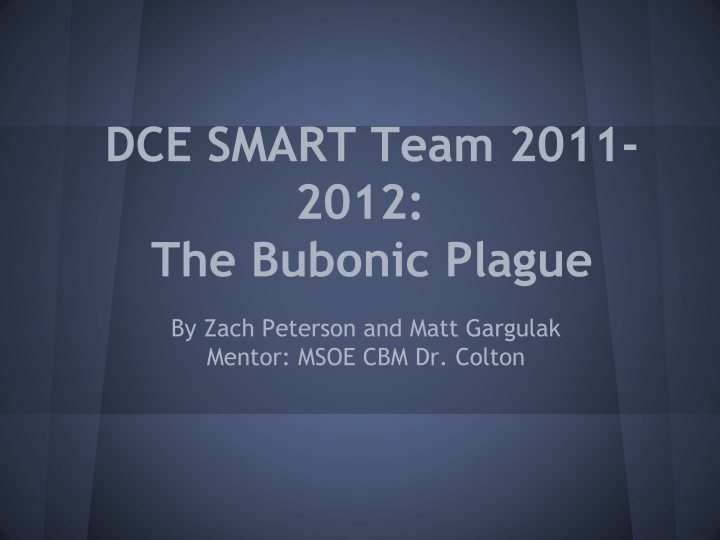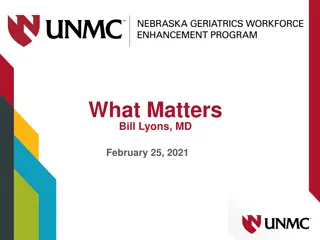
Unveiling the History and Importance of the Bubonic Plague
Explore the captivating journey of the Bubonic Plague, from its devastating outbreaks like the Black Death to the scientific understanding of Yersinia Pestis. Learn about the biological warfare strategies of the 14th century and the contagious nature of this historical epidemic that had no cure. Discover the role of surface protein Pla in Gram-negative bacteria and the various forms of Yersinia Pestis that caused havoc in different ways. Delve deep into the significance and transmission of this plague, shedding light on its impact on society and human health.
Download Presentation

Please find below an Image/Link to download the presentation.
The content on the website is provided AS IS for your information and personal use only. It may not be sold, licensed, or shared on other websites without obtaining consent from the author. If you encounter any issues during the download, it is possible that the publisher has removed the file from their server.
You are allowed to download the files provided on this website for personal or commercial use, subject to the condition that they are used lawfully. All files are the property of their respective owners.
The content on the website is provided AS IS for your information and personal use only. It may not be sold, licensed, or shared on other websites without obtaining consent from the author.
E N D
Presentation Transcript
DCE SMART Team 2011- 2012: The Bubonic Plague By Zach Peterson and Matt Gargulak Mentor: MSOE CBM Dr. Colton
What is SMART? - Students Modeling A Research Topic - Organize groups - Research the topic - Write an abstract - Use Jmol to recreate biomolecular structure http://upload.w ikimedia.org/wi kipedia/comm ons/b/b0/Jmol _logo.jpg
History of the Bubonic Plague - recorded epidemic - Black Death (1347) - Major outbreak in Europe - Treatment - Eat well, rest, and leave infected areas - Biological Warfare - 14th century armies used bubonic plague to their advantage Plague of Justinian (500s) - First
http://upload.wikimedia.org/wikipedia/commons/1/1b/Bubonic_plague_victims-mass_grave_in_Martigues%2C_France_1720-1721.jpghttp://upload.wikimedia.org/wikipedia/commons/1/1b/Bubonic_plague_victims-mass_grave_in_Martigues%2C_France_1720-1721.jpg
Importance of the Bubonic Plague - - Common in rats Transmitted through fleas to humans - Extremely contagious - Fast-acting - Had no cure http://upload.wikimedia.org /wikipedia/commons/d/d0/Y ersinia_pestis.jpghttp://uplo ad.wikimedia.org/wikipedia/ commons/d/d0/Yersinia_pest is.jpg http://upload.wikimedia.org /wikipedia/commons/c/c1/F lea_infected_with_yersinia_p estis.jpg
Surface Protein - Pla - - - Attracts Plasminogen activator inhibitors (PAI) into negative pocket - Breaks peptide bonds Gram-negative bacteria Attaches to cell walls in the lymph nodes http://micro.digitalpr oteus.com/pics/gra mbacterium.jpg
Yersinia Pestis (Scientific Name) - Most commonly caused by the bite of an infected rodent or parasite Rarely transmitted by human contact Common in unsanitary rural areas Oftentimes fatal - - - http://www.rkm.com.au/imag elibrary/thumbnails/Yersinia1 50.jpg
Yersinia Pestis (Scientific Name) - Comes in three forms - Bubonic (Lymphatic) - Pneumonic (Respiratory) - Septicemic (Circulatory) http://s2.hubimg.com/u/1498965_f260.jpg http://people. uwec.edu/pie rcech/bio/Pict ures/plague3 .gif
Symptoms (Bubonic Plague) - Gangrene - Chills - High fever - Muscle cramps - Seizures - Swollen lymph glands - Skin discoloration - Bleeding of the ears http://rlv.zcache.com/main_symptoms_of_black_death_bu bonic_plague_chart_poster- r7976f470e1824a8eb1fbe096a5b00c6f_azzc8_400.jpg
Why is it less common today? - Increase in overall hygiene - Decrease in infected organisms - Change in climate - (1:56-2:58) http://www.youtube.com/watch?v=pRZYb2Jl22 g






















